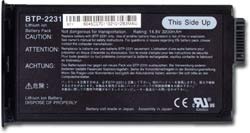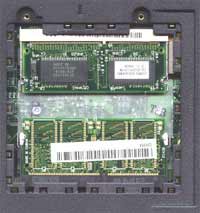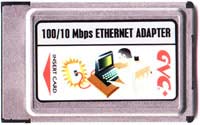All important Battery Life:
|
For portable computers nothing is more important then
battery life. The Acer fairs well here, having a Lithium Ion battery (weighs around 1 lbs) with a
life of about 4 hours. I'd take off about 45 minutes if your spinning a
CD the whole time, and a bit less then that
if you have MP3's going constantly. There is a handy little icon on the
toolbar which shows a rough estimation of battery life, expressed in
percentages. Holding the cursor over the little battery icon,
gives you the value. The computer is also nice enough
to give an on-screen warning when 10% of battery power has been
reached, and suggests you save your work right away. |
|

|
| |
|

|
|
The battery is located at
the front of the computer, accessable from the left side. Also on this
side of the computer are the Power-On switch, the Infrared Port, and the
cooling fan for the CPU (center). |
As with most portables these days, if the battery is
running low, and the AC-adapter is on hand, it can be plugged in at any time -
the computer automatically switches from battery usage to the wall power supply.
Conversely, if plugged into the wall, and seeking a bit of mobility, unplug yourself and
walk freely, the computer will automatically go to battery - which
is hopefully nice and charged. ;-) The AC adapter is optimized for those traveling
the world. It can handle wall voltages of 100-240V, 50-60Hz itself, and spits
out 60W of power.
Speed, Speed, Speed:
The model we have is based upon Intel's Celeron 366Mhz.
Now I know that if individual computers are using the same chip, they
should have about the same performance, and general characteristics. That isn't
quite the case with the mobile version of the Celeron - it seems to run
faster then my PPGA equivalent.
Programs load up very quickly (64MB under the hood), but changing between
programs can be a bit slow at times, and sometimes HD access lags have an effect
on overall usability. There are times when the computer just pauses with HD
chirping away, freezing work for a few seconds. This doesn't happen very often
at all, but when it does, it's somewhat annoying.
 |
As with the
modem, a small metal cover on
the bottom of the computer is removed by screw to reveal the RAM slots -
currently holding 64MB, but expandable to
256MB. |
Networking is a Must:
This Acer has a PCMCIA 10/100 GVC NIC card in
it. A laptop without a network card is severely limited in its use.
Transferring info over the internet is limited to connection speeds and moving
info over a 1.4 MB floppy is unrealistic.
Enter in the NIC card. Connecting on the fly is easy - a small adapter
cable comes with the PCMCIA card and converts the Series II socket to RJ-45
(Ethernet Cat-5 Cable). I found it entirely indispensable to the point I carried
around a small 10/100 NIC card and length of crossover Ethernet cable
incase my hosts' computer was without one. There were no problems connecting up
to another computer - simply plug in adapter, plug in Ethernet cable and check
out the network. As long as sharing is enabled that is. Transfer of files was
quick and easy to my hosts' computer, greatly increasing the usability of the
Acer with little affect on the computer while transferring files.
 |
 |
|
NIC card |
Series II to RJ-45 adapter
cable. |
Lifting weights:
With
all the components crammed into the
laptop, and the dense materials that make up today's batteries, weight is a major
issue. The Acer 512T weighs in at 7.3 lbs.. not an amazingly light machine, but not
a chunk of lead either. To be fair, I lugged around the computer for
a day (minus 20 degree weather with no ill affects either) in a shoulder bag
by itself and it wasn't a problem at all.
On this trip I lugged it around in the same bag (which was full of a bunch of
stuff I needed) and my shoulder was a bit sore by the end of the day. Hmm,
actually I lost feeling in my left arm... That wasn't the computers fault, but
then when would you go on a trip with *only* the computer in a bag - more likely
plane tickets, notebooks, cell phone, and maybe a magazine or two would
accompany the computer. With all the stuff I needed to carry along, the total
weight was around 15 pounds. The overall dimensions of the 512T are: W12.1" x
D10.1" x H1.8"
I/O's:
 |
- IrDA-compliant FIR (Fast Infrared)
wireless communications port
- Universal Serial Bus (USB) port
- Parallel port (ECP compliant)
- RS-232 (16550 compatible) serial
port
- PS/2 keypad/keyboard/mouse port
- External video port
- Port replicator
connector
|
Conclusions:
To summarize,
the Acer 512T
has a few minor areas
which could be touched up to deliver a superior product, but even
considering those few bugs I would still recommend it as an excellent laptop
for anyone who travels. That it still works after everything I've recently put it through
is a testament to its durability. The key features I particularly like are
the built-in CD player, and on-board 56K modem and all around well
design.
Hopefully my real-life on the road experience with this computer will
give a fair idea of its quirks and in general what to expect of it. Should
anyone be considering this as their portable computer solution I would recommend
it with a rating of 8.7 out of 10.
